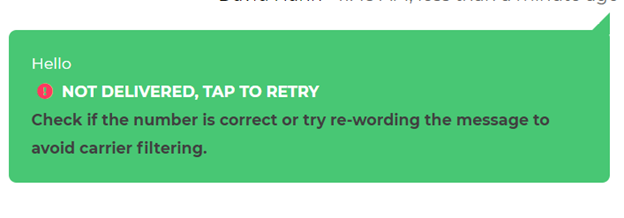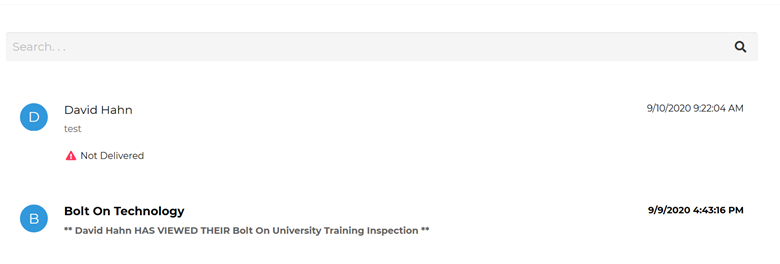
How Carrier Filtering Impacts Your Texting with Customers
Carrier filtering can be a stressful feature for business owners attempting to communicate with their customers via text messaging. We’ll break down the what, why, and how so you’re aware of this feature implemented by wireless carriers and the potential impacts it can make.
What is Carrier Filtering?
Wireless Carrier Filtering is a tool that Wireless Network Carriers put in place in order to operate in accordance with local, state, and federal regulations concerning communication. Many businesses use text messages to reach customers, and those using the text messages are most commonly companies that are sending a high volume of messages every day. Text messaging is the most cost-efficient type of messaging, so many businesses elect to utilize it above others.
The filters are put in place in order to protect against, well, junk. Wireless Carrier Filtering filters out any messages from a software application that would be deemed “offensive” to a recipient. The criteria for what is considered offensive usually relates to spam, unsolicited messages, and messages with questionable content. Great for the user experience.
The Wireless Carrier Filtering can be a double-edged sword, though—while it does a great job filtering out the undesirable spam, it also filters out key messages that businesses are sending to customers in order to conduct business. The filtering of text messages by wireless carriers can cause a hassle for many businesses attempting to communicate with their customers on a larger scale via text messaging.
Application-To-Phone (A2P)
A way for businesses to send messages to customers is through A2P or Application-To-Phone. Simply put, these are messages coming from a program and being sent to a cellular device. In the case of BOLT ON, these messages—such as an appointment reminder to a customer—are sent from Message Manager to a customer’s personal device.
When a text message is sent, it takes a specific route in order to be delivered to the correct recipient. Phone to phone text messages take direct routes, while A2P messages take “Grey Routes.” Grey Routes are indirect routes that bounce the message around until it hits the correct recipient.
How Do Wireless Carriers Use Filtering Systems?
The criteria for filtering messages isn’t standard across the industry—each carrier has created their own method for filtering. Also, the criteria isn’t necessarily solid and fixed. Based on the constant improvement of filtering parameters we can assume wireless companies use a learning machine that constantly learns new aspects to filter. This moving target can be frustrating to deal with, but we do know of some factors that affect the filters:
Wireless Carrier Subscribers: Subscribers themselves play a part in the increased filtering of messages. They are encouraged by their Wireless Carriers to report any spam, fraud, and abuse to their wireless subscribers.
National Events: A big contributor to Wireless Carrier Filtering is caused by National Events. A good example of a National Event would be an election. During the last primary, we noticed an increase in carrier filtering to the point where some carriers were filtering out 60-80% of all messages being sent. During a large-scale national event such as a national election, wireless carriers will put a buffer leading up to the event, and after. The length of these buffers are about a month long, bookending the election period.
Unfortunately, only wireless carriers know exactly how their filtering works. Their goal is to safeguard their secrets in order to prevent spammers who seek to get around their filters. Carriers will not notify you if a message is filtered, instead they mark the message as delivered. This prevents spammers from eventually coming up with a formula to combat the filters.

BOLT ON Beats The Carrier Filtering
BOLT ON TECHNOLOGY has been able to formulate a solution for beating the carrier filtering and ensuring your messages are being delivered to your customers. No longer will you have to worry if your messages are not being delivered to your recipients. Text and communicate with your customer base while confidently knowing your messages have been received loud and clear because BOLT ON is in your corner.
How Have We Done This?
BOLT ON has added some updates within Message Manager Pro and NextGear's Messaging Module, which allows a shop to send and receive important information.
- Background Enhancements: Our team has added some enhancements to our products which greatly reduce the frequency at which messages from BOLT ON products get caught up in carrier filtering. As it stands, BOLT ON's products are currently the only software solution that has the ability to combat carrier filtering.
- Notifications: In the event a text message is not delivered, the shop will be notified via a pop-up notification. For those with Message Manager, shops will see this through the BOLT ON Service for Message Manager, and NextGear users will see this at the top of the screen. If a shop receives a "Not Delivered" notification, our team recommends rewording the message or changing the phone number—that should allow the text to get through the carrier filters. If a text goes out to a landline it will notify the shop that this number is a landline that cannot receive text messages. We do this by doing a look up of the number to see what the phone number is classified as. A phone number is classified by the carrier.

The BOLT ON team has conducted a number of extensive tests in order to determine the true impact this issue has had on our shops and their customers.
After we initially put these changes into place, we realized that 5% of text messages were still not being delivered. As we dug deeper into the issue, our team discovered that 80% of the texts being marked as "Not Delivered" even after changes were implemented, were due to the phone numbers being used for landline phones. This means that the changes our team made brought down the overall carrier filtering rate down to just 1%.

.png?width=695&height=248&name=TC%20Blog%20Banner%20(6).png)


